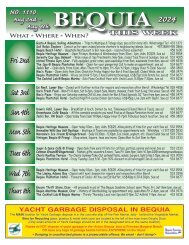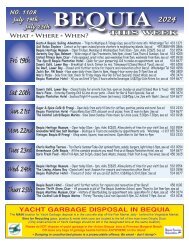Caribbean Compass Yachting Magazine - December 2020
Welcome to Caribbean Compass, the most widely-read boating publication in the Caribbean! THE MOST NEWS YOU CAN USE - feature articles on cruising destinations, regattas, environment, events...
Welcome to Caribbean Compass, the most widely-read boating publication in the Caribbean! THE MOST NEWS YOU CAN USE - feature articles on cruising destinations, regattas, environment, events...
You also want an ePaper? Increase the reach of your titles
YUMPU automatically turns print PDFs into web optimized ePapers that Google loves.
A Sailors Guide Looks at 40<br />
Interview with author Chris Doyle<br />
DECEMBER <strong>2020</strong> CARIBBEAN COMPASS PAGE 20<br />
<strong>Caribbean</strong> <strong>Compass</strong>: Chris, your<br />
Sailors Guide to the Windward<br />
Islands is celebrating its 40th<br />
Anniversary with the publication of<br />
the latest edition. Congratulations!<br />
Other cruising guides covering the<br />
Windwards to a greater or lesser<br />
degree had already been published<br />
by 1980, including those by Don<br />
Street, Hart and Stone, Carleton<br />
Mitchell, et al. What was the<br />
impetus that led you to write your<br />
first edition of Sailors Guide to the<br />
Windward Islands? What did you<br />
think would set it apart or be<br />
an improvement?<br />
Chris Doyle: In the late ’70s<br />
bareboating was taking off and<br />
changing the waterfront.<br />
Whenever I was ashore people<br />
from bareboats would ask me<br />
“Where can I find this?” “Who<br />
sells that?” “Is there a mechanic<br />
nearby?” The other cruising<br />
guides did not answer these<br />
questions, leaving us cruisers<br />
and charter captains to fill the<br />
slack by being unpaid and<br />
unofficial tourist information<br />
officers. That was fine, but<br />
sometimes a bit much when we<br />
From a sailing family on the south coast of<br />
England, Chris earned a doctorate in psychology<br />
before sailing to the <strong>Caribbean</strong> in 1969 aboard a<br />
wooden Colin Archer called Sugar Creek<br />
and becoming a resident of Grenada.<br />
What was I going<br />
to use for a<br />
cover? My friend<br />
Xandra Fisher in<br />
Grenada had<br />
created an<br />
antique-style map<br />
of the Windwards<br />
that used to sell<br />
well as a<br />
souvenir in the<br />
shops. She let me<br />
use it, and I liked<br />
it so much that it<br />
was on the cover<br />
for some years.<br />
CRUISING GUIDE PUBLICATIONS<br />
change over many years. This meant it had to be simple: just basic navigation<br />
information that anyone could follow, and a quick description of each anchorage. He<br />
got a bunch of good photos, and printed the book as a slim, 11-by-13-inch, spiralbound,<br />
colorful paperback, and for years it was popular. I took a look at it at the<br />
other day and was amazed to see an aerial photo of Rodney Bay Lagoon: a few<br />
buildings, and nothing else except one little Steven’s Yachts dock.<br />
I was starting from somewhere, though the new book I envisaged would be a<br />
different beast. I was no businessman and had no idea of how to deal with printers.<br />
I started by writing it and drawing sketch charts, and then tried to get a publisher<br />
interested. None were, which I think now was fortunate. I had no money in those<br />
days, which precluded color work, but I was lucky to know Sally Erdle, now editor<br />
of <strong>Caribbean</strong> <strong>Compass</strong>, who in those days had time to express her brilliant and<br />
twisted sense of humor by drawing cartoons for fun. She illustrated all of the early<br />
guides and came up with some wonderful cartoons including a recipe for Fish Lips<br />
Jello, an after-charter “tropical depression dept.,” and much more.<br />
A printer in Barbados gave me a quote, which was for more money than I had, but<br />
was as good as I was going to get. So, when someone said, “Oh, sell advertising,” I<br />
did. I sold some ads cheaply, and to my amazement I found that people did not think<br />
I was nuts, were willing to buy ads, and were trusting and enthusiastic.<br />
So off I went to Barbados, with my typewritten book, stayed for many weeks at the<br />
Yoga Center, which was like a youth hostel with shared rooms, and spent all day at<br />
the printer. Everything was so different in those days. Personal computers were not<br />
yet a fact of life nor was desktop publishing. The book was carefully turned into<br />
typeset on their typesetting machine, the output glued to artboard, and all the art<br />
photographed. I would sit a in a little room drawing the sketch charts. What was I<br />
going to use for a cover? My friend Xandra Fisher in Grenada had created an<br />
antique-style map of the Windwards that used to sell well as a souvenir in the shops.<br />
She let me use it, and I liked it so much that it was on the cover for some years.<br />
When the printer’s bill came, I found I could not pay all of it. I was so naïve that I<br />
thought the price the printer’s salesman gave me was what I was going to pay. I had<br />
no idea it did not include all the prepress work. I suggested that their only hope of<br />
payment was to let me have the books so I could sell them and pay them back. They<br />
did (and so did I). I found a small cargo vessel going overnight to St. Vincent, loaded<br />
my books on board and took them to another good friend, Frances Punnett, a.k.a.<br />
Tipi, who became my first wholesale agent.<br />
Was it an immediate success?<br />
Not at all. Bookstores were all happy to take it on consignment, but it was<br />
unknown. It was also cheap — being impecunious myself, I figured cruisers would<br />
not want to buy it if it cost more than US$5. Compared to the Sailors Guide today it<br />
was simple, in black-and-white except for the cover.<br />
I needed to get it known, so I kept a stock on my boat. I was pretty good at<br />
windsurfing on those old big boards with small sails, so I would put some guides in<br />
a backpack on my back, and windsurf from boat to boat selling them. They began to<br />
get some fans; the cartoons helped. It was not slick, but it was entertaining.<br />
It took some years till it was paying for itself and contributing to me, rather than<br />
the other way round. Several things led to that. I remember once someone<br />
congratulated me on what a great little “goldmine” it was, I thought “uh?” Then<br />
charter companies realized that the Sailors Guide helped keep their customers off the<br />
reefs. I would go to them when updating every edition and find out if there was any<br />
place that several people had come to grief. When there was, I would rewrite the<br />
sailing directions and exaggerate the offending reef in the sketch map a bit, which<br />
helped solve the problem.<br />
—Continued on next page<br />
SALLY ERDLE<br />
were asked the same thing three times in a row. This happened most often in Bequia,<br />
often cruisers’ first stop. I was in Bequia and went to a party on the motor charter<br />
boat Tor Helga, where George Harris, the captain, was host. George was good at<br />
partying and I found him manning the bar and deftly pouring drinks, wearing<br />
nothing but a plastic apron. People asked, “George, is that all you’re wearing?” He<br />
responded with a quick pirouette leaving them in no doubt. In this highly intellectual,<br />
smoky, and alcoholic atmosphere, I complained to George about the poor state of<br />
information in the other cruising guides, and that their lack of information was<br />
making other people’s charter guests a pain. “Simple,” he said. “Time you wrote your<br />
own!” And that really was how it started.<br />
So that gave you the idea, where did you go from there?<br />
At the time this happened I was running my own 41-foot sailboat, Helos, as a<br />
crewed charter boat. But before that, I had worked as a skipper for Stevens Yachts.<br />
Bill Stevens wanted his own Stevens Yachts Cruising Guide to sell, advertise his<br />
business, and put onboard his boats. He asked me to write it. I had no expertise for<br />
this but, given his alternatives among the other skippers, I was not a bad choice. He<br />
pointed out he was going to print an enormous number of copies as it was much<br />
cheaper that way, therefore I should not include any information that was likely to<br />
Sally’s most<br />
commented-on<br />
cartoon from an<br />
early edition, ‘Fish<br />
Lips Jello’<br />
would probably<br />
be considered<br />
politically<br />
incorrect today.

















